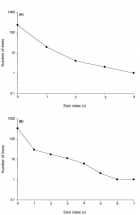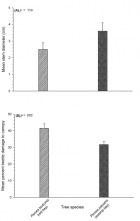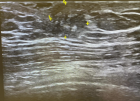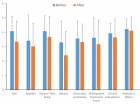Abstract
Research Article
Assessing the stand size of bay trees (Persea spp.) after exposure to laurel wilt disease in a North Florida Preserve
Anthony M Rossi* and Christopher Bentzien
Published: 04 June, 2019 | Volume 3 - Issue 2 | Pages: 042-049
Although laurel wilt disease was first reported in the United States in 2002 from redbay trees (Persea borbonia) around Savannah, Georgia it has rapidly spread throughout the southeastern coastal plain including Georgia and Florida. In the current study, transects were used to assess the spread and impact of the disease on two native bay trees redbay (P. borbonia) and swampbay (P. palustris) from north Florida in a semi-naturalized ecological preserve. Although tree size and mortality rates have been reported previously, this study provides the first size-based static life tables for both species. While a significantly higher percent (76%) of swampbay trees exhibited signs of laurel wilt disease compared to redbay trees (62%); redbay had more of its canopy damaged by the disease (41% vs. 32% for redbay vs. swampbay respectively); this resulted in a significantly smaller stem diameter for P. borbonia compared to swampbay, both species are experiencing significant declines due to the disease. Both species exhibited a Type III survivorship curve in which the vast majority of individuals were in the smallest size class (average stem diameter was only 2.5 and 3.6 cm for redbay and swampbay respectively). Although traditionally, population age (or size) structure that is heavily biased toward younger or smaller size classes suggests that the population is likely to expand in the future, for these bay trees high mortality rate due to beetle/fungal infestation of larger size classes is responsible for this trend; the smallest size classes are largely free from beetle infestation and laurel wilt disease because the stem diameter is likely insufficient to support beetle development. Results from this study suggest that swampbay is also highly susceptible to laurel wilt disease and its populations are likely to exhibit a similar (albeit slower) decline in Florida’s wetland and mesic ecosystems.
Read Full Article HTML DOI: 10.29328/journal.jpsp.1001030 Cite this Article Read Full Article PDF
References
- Snyder JR. Ecological implications of laurel wilt infestation on Everglades tree islands in southern Florida. US Geological Survey Open-file Report. 2014; 1225: 18. Ref.: https://bit.ly/2Kn0tLs
- Hughes MA, Smith JA, Ploetz RC, Kendra PE, Mayfield AE, et al Recovery plan for laurel wilt on redbay and other forest species caused by Raffaelea lauricola and disseminated by Xyleborus glabratus. Plant Health Progress. 2011; 16: 173-210. Ref.: https://bit.ly/2Klxk3d
- Evert RF, Eichhorn SE. Raven Biology of Plants, 8th Edition. Freeman/Palgrave Mcmillan. Ann Bot. 2013; 113: 900. Ref.: http://bit.ly/2WTcpw4
- Harrington TC, Yun HY, Lu SS, Goto H, Aghayeva DN, et al. Isolations from the redbay ambrosia beetle, Xyleborus glabratus, confirm that the laurel wilt pathogen, Raffaelea lauricola, originated in Asia. Mycologia. 2011; 103: 1028-1036. Ref.: https://bit.ly/2W9sNTG
- Pisani C, Ploetz RC, Stover E, Ritenour MA, Scully B. Laurel wilt in avocado: Review of an emerging disease. Int J Plant Biol Res. 2015; 3: 1043. Ref.: https://bit.ly/2JWypPI
- Hulcr J, Rountree NR, Diamond SE, Stelinski LL, Fierer N, et al. Mycangia of ambrosia beetles host communities of bacteria. Microb Ecol. 2012; 64: 784-793. Ref.: https://bit.ly/2wIwWEd
- Koch FH, Smith WD. Spatio-temporal analysis of Xyleborus glabratus (Coleoptera: Curculionidae: Scolytinae) invasion in eastern U.S. forests. Environ Entomol. 2008; 37: 442-452. Ref.: https://bit.ly/2Z4n7ws
- Mayfield III AE, Thomas MC. The redbay ambrosia beetle, Xyleborus glabratus Eichhoff (Scolytinae: Curculionidae). 2009; 4. Ref.: https://bit.ly/2Wb4Hbo
- Evans EA, Crane J, Hodges A, Osborne JL. Potential economic impact of laurel wilt disease on the Florida avocado industry. HortTechnology. 2010; 20: 234-238. Ref.: https://bit.ly/2W5HlUA
- Fraedrich SW, Harrington TC, Best GS. Xyleborus glabratus attacks and systemic colonization by Raffaelea lauricola associated with diback of Cinnamomum camphora in the southeastern United States. Forest Pathology. 2015; 45: 60-70. Ref.: https://bit.ly/2XvwZ1y
- Hulcr J, Lou Q. The redbay ambrosia beetle (Coleoptera: Curculionidae) prefers Lauraceae in its native range: records from the Chinese national insect collection. Florida Entomologist. 2013; 96: 1595-1596. Ref.: https://bit.ly/2Xoztii
- Mayfield III AE, Peña JE, Crane JH, Smith JA, Branch CL, et al. Ability of redbay ambrosia beetle (Coleoptera: Curculionidae: Scolytinae) to bore into young avocado (Lauraceae) plants and transmit the laurel wilt pathogen (Raffaelea sp.). Florida Entomologist. 2008; 91: 485-487. Ref.: https://bit.ly/2HQrNAa
- Cameron RS, Hanula J, Fraedrich S, Bates C. Progression and impact of laurel wilt disease within redbay and sassafras populations in southeast Georgia. Southeastern Naturalist. 2015; 14: 650-674. Ref.: https://bit.ly/2WdrDXH
- Kendra PE, Montgomery WS, Niogret J, Epsky ND. An uncertain future for American Lauraceae: a lethal threat from redbay ambrosia beetle and laurel wilt disease (A Review). Am J Plant Sci. 2013; 4: 727-738. Ref.: https://bit.ly/2QFJJAr
- Fraedrich SW, Harrington TC, Rabaglia RJ, Mayfield AE 3rd, Hanula JL, et al. A fungal symbiont of the redbay ambrosia beetle causes a lethal wilt in redby and other Lauraceae in the southeastern United States. Plant Disease. 2008; 92: 215-224. Ref.: https://bit.ly/2wuZnoX
- Hughes M, Smith JA, Mayfield AE 3rd, Minno MC, Shin K. First report of laurel wilt disease caused by Raffaelea lauricola on pondspice in Florida. Plant Disease. 2011; 95: 1588-1589. Ref.: https://bit.ly/2IcwUtm
- Nelson G. The Shrubs and Woody Vines of Florida. Pineapple Press, Sarasota. 1996; 391. Ref.: https://bit.ly/2IiEEKB
- Duncan WH, Duncan MB. Trees of the Southeastern United States. University of Georgia Press, Athens. 1998; 322. Ref.: https://bit.ly/2WkAI5D
- Sibley DA. The Sibley Guide to Trees. Knopf, New York. 2009; 427. Ref.: https://amzn.to/2Klpg2x
- Nelson G, Earle CJ, Spellenberg R. Trees of Eastern North America. Princeton University Press, Princeton. 2014; 720. Ref.: https://bit.ly/2WFmqvM
- Leak WB. Relationship of tree age to diameter in old-growth northern hardwoods and spruce-fir. United States Department of Agriculture, Research Note NE. 1985; -329: 4. Ref.: https://bit.ly/2KnE0ho
- Lukaszkiewicz J, Kosmala M. Determining the age of streetside trees with diameter at breast height-based mulifactoral model. Agriculture and Urban Forestry. 2008; 34: 137-143. Ref.: https://bit.ly/2WjW1o0
- Parresol BR, Devall MS. Patterns of diametric growth in stem-analyzed laurel trees (Cordia alliodora) in a Panamanian forest. The Southwestern Naturalist. 2013; 58: 170-178. Ref.: https://bit.ly/313dNut
Figures:

Figure 1

Figure 2
Similar Articles
-
Impact of Calcium Phosphate Nanoparticles on Rice PlantHrishikesh Upadhyaya*,Lutfa Begum,Bishal Dey,P K Nath,S K Panda. Impact of Calcium Phosphate Nanoparticles on Rice Plant. . 2017 doi: 10.29328/journal.jpsp.1001001; 1: 001-010
-
The Effects of Pharmacological Carbonic Anhydrase Suppression on Defence Responses of Potato Leaves To Phytophthora InfestansMagdalena Arasimowicz-Jelonek*,Jolanta Floryszak-Wieczorek. The Effects of Pharmacological Carbonic Anhydrase Suppression on Defence Responses of Potato Leaves To Phytophthora Infestans. . 2017 doi: 10.29328/journal.jpsp.1001002; 1: 011-025
-
Phytochemical content of leaf and stem of Marsilea quadrifolia (L.)Rajangam Udayakumar*,Karikalan Gopalakrishnan. Phytochemical content of leaf and stem of Marsilea quadrifolia (L.). . 2017 doi: 10.29328/journal.jpsp.1001003; 1: 026-037
-
Antagonistic features displayed by Plant Growth Promoting Rhizobacteria (PGPR): A ReviewMohsin Tariq*,Muhammad Noman,Temoor Ahmed,Amir Hameed,Natasha Manzoor,Marriam Zafar. Antagonistic features displayed by Plant Growth Promoting Rhizobacteria (PGPR): A Review . . 2017 doi: 10.29328/journal.jpsp.1001004; 1: 038-043
-
Wild-type Agrobacterium rhizogenes-mediated gene transfer in plants: Agrobacterium virulence and selection of transformantsShu Wei*,Muhammad Abdullah,Ferdinand L Shamalla,Mohammad M Rana. Wild-type Agrobacterium rhizogenes-mediated gene transfer in plants: Agrobacterium virulence and selection of transformants. . 2017 doi: 10.29328/journal.jpsp.1001005; 1: 044-051
-
Effects of Vochysia haenkeana extract on the neuromuscular blockade induced by Bothrops jararaca venom on chick biventer cervicis preparation in vitroYoko Oshima-Franco*,Fernanda Dias da Silva,Natália Tribuiani,Isadora Caruso Fontana Oliveira,Regina Yuri Hashimoto Miura,Rafael S Floriano,Márcio Galdino dos Santos,Sandro Rostelato-Ferreira. Effects of Vochysia haenkeana extract on the neuromuscular blockade induced by Bothrops jararaca venom on chick biventer cervicis preparation in vitro. . 2017 doi: 10.29328/journal.jpsp.1001006; 1: 052-058
-
HBV: Genomic Structure, HBVsAg Isolation and innovative Virotherapy Initiation in the Middle EastAboul-Ata E Aboul-Ata*,Essam M Janahi,I M El-Kalamawy,Kathleen Hefferon,Amal Mahmoud. HBV: Genomic Structure, HBVsAg Isolation and innovative Virotherapy Initiation in the Middle East . . 2017 doi: 10.29328/journal.jpsp.1001007; 1: 059-061
-
Physiological impact of Zinc nanoparticle on germination of rice (Oryza sativa L) seedUpadhyaya H*,Roy H,Shome S,Tewari S,Bhattacharya MK,Panda SK. Physiological impact of Zinc nanoparticle on germination of rice (Oryza sativa L) seed . . 2017 doi: 10.29328/journal.jpsp.1001008; 1: 062-070
-
Effects of Site Factors on the Clonal Growth of Phyllostachys bambusoides f. shouzhu YiXiaohong Gan*,Lijuan Chen,Cuibin Tang,Xia Zhang. Effects of Site Factors on the Clonal Growth of Phyllostachys bambusoides f. shouzhu Yi. . 2017 doi: 10.29328/journal.jpsp.1001009; 1: 071-079
-
Evaluation of genetic diversity in germplasm of paprika (Capsicum spp.) using random amplified polymorphic DNA (RAPD) markersRueda-Puente EO*,Renganathan P,Ruíz-Alvarado C,Hernández-Montiel LG,Prasath Duraisamy. Evaluation of genetic diversity in germplasm of paprika (Capsicum spp.) using random amplified polymorphic DNA (RAPD) markers. . 2017 doi: 10.29328/journal.jpsp.1001010; 1: 080-086
Recently Viewed
-
Pneumothorax as Complication of CT Guided Lung Biopsy: Frequency, Severity and Assessment of Risk FactorsGaurav Raj*,Neha Kumari,Neha Singh,Kaustubh Gupta,Anurag Gupta,Pradyuman Singh,Hemant Gupta. Pneumothorax as Complication of CT Guided Lung Biopsy: Frequency, Severity and Assessment of Risk Factors. J Radiol Oncol. 2025: doi: 10.29328/journal.jro.1001075; 9: 012-016
-
The Police Power of the National Health Surveillance Agency – ANVISADimas Augusto da Silva*,Rafaela Marinho da Silva. The Police Power of the National Health Surveillance Agency – ANVISA. Arch Cancer Sci Ther. 2024: doi: 10.29328/journal.acst.1001046; 8: 063-076
-
A Comparative Study of Serum Sodium and Potassium Levels across the Three Trimesters of PregnancyOtoikhila OC and Seriki SA*. A Comparative Study of Serum Sodium and Potassium Levels across the Three Trimesters of Pregnancy. Clin J Obstet Gynecol. 2023: doi: 10.29328/journal.cjog.1001137; 6: 108-116
-
Chaos to Cosmos: Quantum Whispers and the Cosmic GenesisOwais Farooq*,Romana Zahoor*. Chaos to Cosmos: Quantum Whispers and the Cosmic Genesis. Int J Phys Res Appl. 2025: doi: 10.29328/journal.ijpra.1001107; 8: 017-023
-
Phytochemical Compounds and the Antifungal Activity of Centaurium pulchellum Ethanol Extracts in IraqNoor Jawad Khadhum, Neepal Imtair Al-Garaawi*, Antethar Jabbar Al-Edani. Phytochemical Compounds and the Antifungal Activity of Centaurium pulchellum Ethanol Extracts in Iraq. J Plant Sci Phytopathol. 2024: doi: 10.29328/journal.jpsp.1001137; 8: 079-083
Most Viewed
-
Evaluation of Biostimulants Based on Recovered Protein Hydrolysates from Animal By-products as Plant Growth EnhancersH Pérez-Aguilar*, M Lacruz-Asaro, F Arán-Ais. Evaluation of Biostimulants Based on Recovered Protein Hydrolysates from Animal By-products as Plant Growth Enhancers. J Plant Sci Phytopathol. 2023 doi: 10.29328/journal.jpsp.1001104; 7: 042-047
-
Sinonasal Myxoma Extending into the Orbit in a 4-Year Old: A Case PresentationJulian A Purrinos*, Ramzi Younis. Sinonasal Myxoma Extending into the Orbit in a 4-Year Old: A Case Presentation. Arch Case Rep. 2024 doi: 10.29328/journal.acr.1001099; 8: 075-077
-
Feasibility study of magnetic sensing for detecting single-neuron action potentialsDenis Tonini,Kai Wu,Renata Saha,Jian-Ping Wang*. Feasibility study of magnetic sensing for detecting single-neuron action potentials. Ann Biomed Sci Eng. 2022 doi: 10.29328/journal.abse.1001018; 6: 019-029
-
Pediatric Dysgerminoma: Unveiling a Rare Ovarian TumorFaten Limaiem*, Khalil Saffar, Ahmed Halouani. Pediatric Dysgerminoma: Unveiling a Rare Ovarian Tumor. Arch Case Rep. 2024 doi: 10.29328/journal.acr.1001087; 8: 010-013
-
Physical activity can change the physiological and psychological circumstances during COVID-19 pandemic: A narrative reviewKhashayar Maroufi*. Physical activity can change the physiological and psychological circumstances during COVID-19 pandemic: A narrative review. J Sports Med Ther. 2021 doi: 10.29328/journal.jsmt.1001051; 6: 001-007

HSPI: We're glad you're here. Please click "create a new Query" if you are a new visitor to our website and need further information from us.
If you are already a member of our network and need to keep track of any developments regarding a question you have already submitted, click "take me to my Query."























































































































































